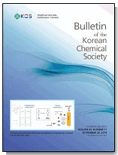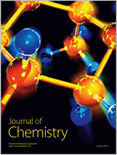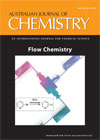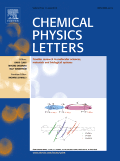
Journal of the Mexican Chemical Society
Scope & Guideline
Pioneering Research for a Sustainable Chemical Future
Introduction
Aims and Scopes
- Sustainable Chemistry:
Research that emphasizes environmentally friendly chemical processes, such as green synthesis methods and the use of sustainable materials. - Nanotechnology and Materials Science:
Studies on nanomaterials, including their synthesis, characterization, and applications in various fields such as electronics and catalysis. - Computational Chemistry:
Theoretical studies utilizing computational methods to explore molecular structures, reactions, and properties, particularly through Density Functional Theory (DFT) and molecular docking. - Phytochemistry and Natural Products:
Investigation of chemical compounds derived from plants, focusing on their biological activities, nutritional benefits, and potential therapeutic applications. - Electrochemistry:
Research involving electrochemical processes, including sensor development, energy conversion systems, and corrosion studies. - Biochemistry and Medicinal Chemistry:
Exploration of biochemical interactions and the development of novel compounds with potential therapeutic effects, including studies on enzyme inhibition and antimicrobial properties.
Trending and Emerging
- Green and Sustainable Chemistry:
An increasing number of publications focus on sustainable practices, including green synthesis and environmentally friendly materials, reflecting a global trend towards sustainability in chemical research. - Nanotechnology Applications:
There is a notable rise in studies addressing the synthesis and application of nanomaterials, particularly in catalysis, drug delivery, and environmental remediation. - Bioactive Compounds and Natural Products:
Research on the extraction, characterization, and application of bioactive compounds from natural sources is gaining traction, emphasizing the therapeutic potential of phytochemicals. - Computational and Theoretical Studies:
An upsurge in computational chemistry studies, particularly those using DFT and molecular docking, indicates a trend towards integrating theoretical approaches with experimental validation. - Electrochemical Innovations:
Emerging research focuses on novel electrochemical sensors and energy conversion technologies, showcasing advancements in electrochemistry for environmental and energy applications.
Declining or Waning
- Traditional Organic Synthesis:
Research focused solely on conventional organic synthesis methods without integrating green chemistry principles seems to be decreasing, as the field shifts towards more sustainable practices. - General Analytical Chemistry:
While analytical chemistry remains important, specific studies lacking innovative approaches or applications in current environmental or health contexts are becoming less common. - Historical Chemical Studies:
Papers that primarily focus on the historical aspects of chemistry or retrospective analyses are less frequently published, indicating a shift towards contemporary and applied research.
Similar Journals

BULLETIN OF THE KOREAN CHEMICAL SOCIETY
Showcasing impactful studies in the world of chemistry.BULLETIN OF THE KOREAN CHEMICAL SOCIETY, published by WILEY-V C H VERLAG GMBH, is a prominent journal in the field of chemistry, with a specific emphasis on miscellaneous chemical research. With an ISSN of 0253-2964 and E-ISSN 1229-5949, this journal serves as a pivotal platform for researchers, professionals, and students who are eager to showcase innovative studies that address both foundational and emerging topics in the discipline. Boasting a commendable Q2 ranking in the 2023 chemistry quartiles, the journal ranks within the top 50th percentile in Scopus, reflecting its commitment to high-quality scientific discourse. The content published within its pages from 1996 to 2024 covers a vast array of subjects, ensuring a multidisciplinary approach to chemical research. The journal’s impact in the academic community is underscored by its accessibility to a global audience, making it an essential resource for those wishing to stay at the forefront of chemical advancements.

Journal of Chemistry
Fostering Collaboration in Chemical ResearchJournal of Chemistry, published by Hindawi Ltd, serves as a critical platform for advancing knowledge in the field of chemistry, particularly in its miscellaneous sub-disciplines. With an impressive 2023 Scopus Rank of #123 out of 408 and positioned in the Q2 quartile, this journal exemplifies a robust academic rigor that appeals to researchers, professionals, and students alike. It features articles related to innovative chemical research and developments, catering to a diverse audience eager to contribute to the growing body of literature in the chemical sciences. The journal has been operational from 2013 to 2024, and its Open Access model ensures that findings are easily accessible to a global audience, fostering collaboration and knowledge sharing. With a commitment to quality and relevance, the Journal of Chemistry continues to play a significant role in shaping contemporary chemical research and education.

AUSTRALIAN JOURNAL OF CHEMISTRY
Exploring the frontiers of chemistry since 1948.The Australian Journal of Chemistry, with an ISSN of 0004-9425 and an E-ISSN of 1445-0038, is a distinguished publication from CSIRO PUBLISHING, dedicated to advancing the field of chemistry since its inception in 1948. Based in Australia, this journal serves as a platform for original research articles, reviews, and innovative studies that encompass a wide spectrum of chemical disciplines, aiming to foster communication and collaboration among researchers globally. Despite its Q3 ranking in the Chemistry (Miscellaneous) category and standing at rank #236 in Scopus’ general chemistry classification, it remains an essential resource for professionals and students seeking to stay informed about emerging trends and discoveries in chemistry. The journal does not offer open access, emphasizing the premium quality of peer-reviewed content that adheres to rigorous academic standards. By bridging theory and practice, the Australian Journal of Chemistry continues to play a crucial role in shaping the future of chemical sciences.

Macedonian Journal of Chemistry and Chemical engineering
Driving Innovation in Chemical Research and PracticeMacedonian Journal of Chemistry and Chemical Engineering, published by the SOC CHEMISTS TECHNOLOGISTS MACEDONIA, is a premier Open Access journal established in 2008, with a focus on disseminating innovative research in the fields of Chemistry and Chemical Engineering. With its ISSN 1857-5552 and E-ISSN 1857-5625, the journal has rapidly gained recognition, achieving a Q3 category rank in both Chemical Engineering and Chemistry for 2023, reflecting its contribution to academic debate and practical advancements within these disciplines. The journal is dedicated to fostering an accessible platform for researchers, practitioners, and students, allowing them to share their findings and insights with a global audience. Situated in Skopje, Macedonia, the journal welcomes submissions that explore a wide array of topics, including but not limited to, theoretical models, experimental studies, and technological innovations. Since transitioning to an Open Access model in 2014, the journal has enhanced its reach and impact, providing unrestricted access to all published articles, thereby encouraging collaboration and knowledge sharing across the scientific community.

Vietnam Journal of Chemistry
Connecting Chemists: Insights from Vietnam and BeyondVietnam Journal of Chemistry, published by WILEY, is a prominent academic journal that serves as a platform for the dissemination of innovative research in the field of chemistry. With its ISSN 0866-7144 and E-ISSN 2572-8288, this journal has made a significant impact on the global scientific community, evidenced by its 2023 Scopus ranking as #274 in the General Chemistry category and a commendable percentile of 32nd. The journal, categorized in the Q3 quartile for miscellaneous chemistry subjects, aims to foster communication among chemists from Vietnam and around the world, encouraging collaboration and the exchange of cutting-edge knowledge. While it currently does not offer Open Access options, the Vietnam Journal of Chemistry is committed to contributing valuable insights from its coverage years spanning from 2018 to 2024, making it a worthy resource for researchers, professionals, and students dedicated to advancing the field of chemistry. Based in the United Kingdom, it stands as a testament to the vibrant research endeavors emerging from Vietnam and beyond.

CHEMICAL PHYSICS LETTERS
Advancing the Frontiers of Chemical PhysicsCHEMICAL PHYSICS LETTERS, published by Elsevier, is a prestigious journal that has been at the forefront of advancing knowledge in the fields of physical and theoretical chemistry and physics since its inception in 1967. With an impressive impact factor reflective of its high-quality research output, this journal holds Q2 quartile rankings in both the Physical and Theoretical Chemistry and Physics and Astronomy categories for 2023. It is recognized as a key platform for disseminating groundbreaking findings, with Scopus rankings placing it within the top 76th and 66th percentiles in its respective categories. Researchers and professionals benefit from its insightful contributions and rigorous peer-review process, making it an essential resource for those engaged in cutting-edge chemical physics studies. Although the journal is not open access, it remains accessible through various institutional subscriptions, ensuring that a wide audience can explore its wealth of knowledge. Located in Amsterdam, Netherlands, the journal continues to drive innovation and collaboration across diverse scientific disciplines.

CHEMICAL JOURNAL OF CHINESE UNIVERSITIES-CHINESE
Nurturing a Community of Chemistry Innovators.CHEMICAL JOURNAL OF CHINESE UNIVERSITIES-CHINESE, published by Higher Education Press, serves as a vital platform for advancing research in the field of chemistry. With a history dating back to 1996, this journal has evolved to encompass a wide range of topics fundamental to the chemistry community, catering to both applied and theoretical perspectives. Although classified in Quartile 4 within the broader chemistry category, it remains a significant contributor to the knowledge base, ranking 281st out of 408 journals in the general chemistry category according to Scopus. Positioned in Beijing, China, the journal aims to foster collaboration among researchers and professionals while disseminating innovative research and developments. By promoting open exchange of ideas in chemistry, it strives to elevate the scholarly dialogue and contribute to ongoing education for students and professionals alike, with its content accessible through institutional subscriptions.

Moroccan Journal of Chemistry
Empowering Chemists with Cutting-Edge Discoveries.Moroccan Journal of Chemistry, published by the University Mohammed Premier Oujda, serves as a pivotal platform for researchers and professionals in the field of chemistry, particularly focusing on diverse and emerging areas within the discipline. Established in 2018, this open-access journal facilitates widespread dissemination of scholarly articles, ensuring that cutting-edge research reaches a global audience. With an ISSN of 2351-812X and categorized in the Q3 quartile for miscellaneous chemistry in 2023, the journal maintains rigorous peer-review standards while fostering an inclusive environment for scientific dialogue. Located in Morocco, it aims to bridge local and international research communities, contributing to the advancement of knowledge in chemistry. As it continues to grow, the Moroccan Journal of Chemistry remains an essential resource for students, educators, and professionals eager to stay abreast of the latest developments in the field.

JOURNAL OF THE CHILEAN CHEMICAL SOCIETY
Connecting Chemists to Shape Tomorrow's Discoveries.The Journal of the Chilean Chemical Society, published by the Sociedad Chilena de Química, serves as a premier platform for disseminating significant research findings in the field of Chemistry. With an ISSN of 0717-9707, this journal has established its presence since 2003, providing open access to a diverse range of studies and advancements in this vital scientific domain. It currently holds a Q3 category ranking in Chemistry (miscellaneous) and ranks 196 out of 408 in the general chemistry category on Scopus, indicating its valuable contributions to the field. Through the journal, researchers, professionals, and students are encouraged to engage with cutting-edge research and foster collaboration among the scientific community in Chile and beyond. The society's commitment to excellence ensures that articles published reflect high-quality research, underpinning the journal’s role in shaping knowledge and innovation in chemistry.

JOURNAL OF THE INDIAN CHEMICAL SOCIETY
Exploring the Frontiers of Chemistry with a Rich HeritageJournal of the Indian Chemical Society, published by Elsevier, stands as a cornerstone in the field of chemistry, particularly representing the rich chemical research emanating from India.
With a significant history dating back to its establishment, this journal encompasses diverse disciplines including Drug Discovery, Electrochemistry, Inorganic Chemistry, Organic Chemistry, and Physical and Theoretical Chemistry, reflecting the evolving landscape of chemical sciences.
Despite being positioned in the Q3 category across multiple quarters, the journal demonstrates promising rankings in various chemistries, highlighting its commitment to advancing the knowledge and application of chemical sciences. While currently not available as an open access journal, the Journal of the Indian Chemical Society is dedicated to providing a platform for high-quality research that fosters innovation and collaboration among researchers, professionals, and students worldwide.
With its continuous publication from 1973 to the present, it serves as an essential repository for cutting-edge findings and developments in chemistry, striving to connect academia with industry and practice.